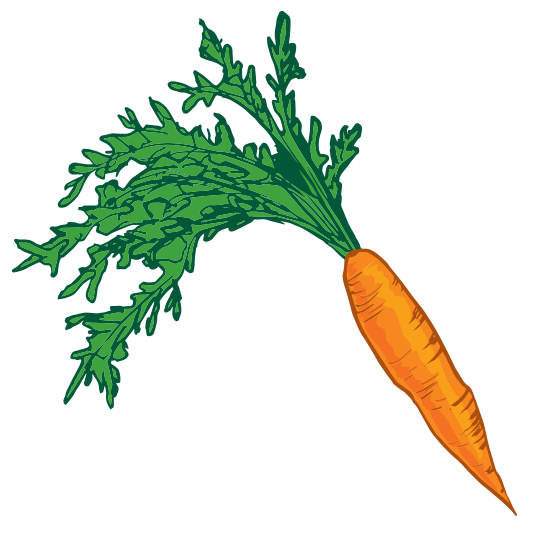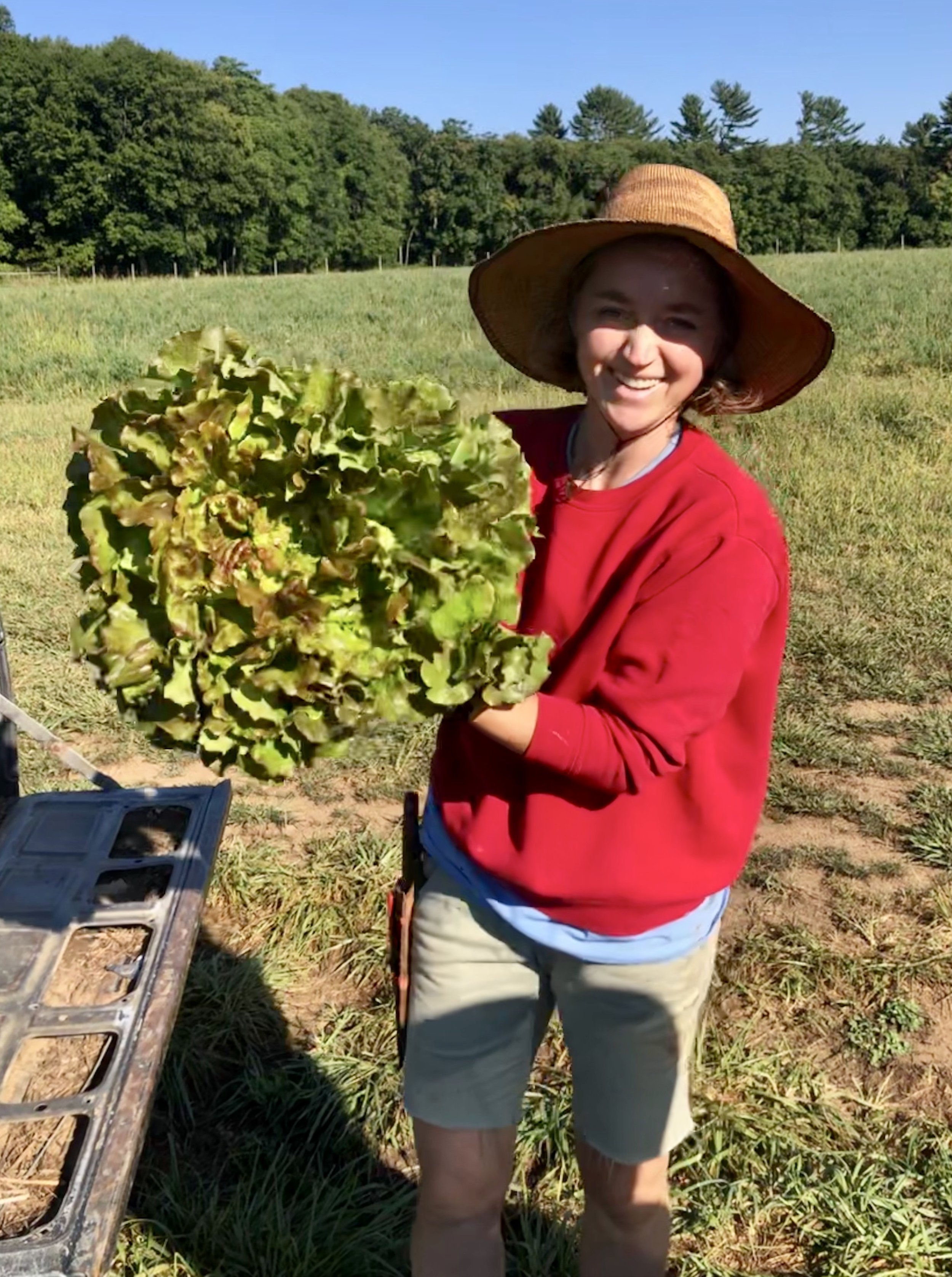Farm News September 5, 2023
Our Farmstand is in full swing:
Tuesday, Thursday, & Friday: 2 - 6:30 PM
Saturday: 8 am - 12:30 pm
******
This week’s newsletter is brought to you by Faye Barry, who heads up the Dahlia Tuber Store and the glorious dahlia plantings on the farm, in addition to helping Dana manage the weekly harvests. Faye initially joined us back in 2010 and 2011, before spending an 8 year stretch in Los Angeles with her husband Michael Sziklai (also of Fort Hill Farm alum fame, 2004). Much to our delight and to the benefit of the farm, Faye returned to work at Fort Hill a few years back (with two little ones in tow), where we hope she has found a second home. If you look, you may just find her in the dahlia patch!
Faye marvels at the size of this summer crisp lettuce specimen.
I know many of our customers are fantastic gardeners, but if your garden is anything like mine, let's face it, it's neglected. We have kids, jobs, parents, school, social life, social media, etc. taking up all our time. Remember those lettuce seedlings you planted back in spring? We picked the first few big leaves and rejoiced in the freshest-possible salad. When we go to our garden lately, we revel in the vigor of nature and the towering, flowering stalks that are the now-bolted lettuce heads swaying in the breeze. Luckily, we can rest assured that there will be delicious lettuce at the farm – stunning heads that could be used as table centerpieces on their own, or chopped up in a bowl.
On the farm, we offer lettuce from early spring through year's end. But as we know from the above cautionary tale, it is not possible with just one planting. In order to have a constant supply, we plant it no less than 20 times a season. This means that every couple weeks, we plant 1,500-2,000 tiny lettuce seeds into flats (that's more than 30,000 lettuces per year!), and carefully tend to them until they are ready for the field. Then, a few weeks after transplanting, we harvest them for you.
Lettuce past, present, and future.
Every once in a while, there is a hiccup, a weather event that will cause a slowdown, when a lettuce patch will come to fruition a little later than hoped. When this happens, Rebecca says we're in a "lettuce crunch," a very satisfying pun for an unfortunate situation. Like most crops on the farm, there are ebbs and flows. Luckily, we grow several varieties that mature on different schedules, and this hiccup is rarely noticeable to the untrained eye.
The final planting of field lettuce is going in the ground today, and all seedlings from here on out will be tucked in greenhouses for protection against frost as the weather cools. The succession planting continues.
CJ sports some loaded bunches of edamame, which are on sale this week! We won’t have edamame for the usual number of weeks due to seed availability, so get it now and blanch and freeze it for another day!
Alternately, a crop that gets planted only once per year is my personal specialty… dahlias. Reminds me of the old infomercial adage (that most of the crew here are too young to remember), "Set it and forget it!" You plop the potato-looking dahlia tuber a couple inches into the ground in spring, and then it runs on autopilot, growing into a big luscious plant.
As we near the end of summer, the dahlia patch is churning out flowers, more every week. The blooms are beautiful to look at, and tasty to eat as well. Did you know that the dahlia plant is completely edible?! Some varieties are more delectable than others, but the only way to find out is to start sampling. So next time you're in a "lettuce crunch" at home, come to the farm stand for a head of lettuce or two, and take a few extra minutes to wander the flower patch. With a bouquet of our organic dahlias, your table's centerpiece will get an upgrade of colorful petals, either off or on your salad!
We hope you enjoy the farm and the harvest,
Rebecca, for Paul and the Fort Hill Farm Crew
Featured veg:
Fingerling potatoes: always a popular item, these are La Ratte fingerlings, which is a fancy French way of saying “the rat” ... a not so nice name for a very tasty spud. These are best roasted, steamed with butter and herbs, or made into a delicate potato salad. Store like all potatoes in a cool (about 50F to 60F), dark place (not the fridge).
Celeriac: This rooty cousin to celery may look odd and may not win any popularity contests, but there’s nothing quite like it for fall. It also adds a refreshing crunch and flavor to summer slaws (see recipe below). Otherwise, peel and cube the root for a yummy addition to soups and stews, roast with other root vegetables, or mix with spuds for a great gratin. The root should be washed, peeled, and then cubed or grated. Store root for months in the fridge crisper.
Also available:
Head lettuce, arugula, salad mix, pea shoots, red and French Breakfast radishes, curly and lacinato kale, rainbow chard, radicchio, scallions, leeks, cilantro, parsley, basil, dill, chives, oregano, rosemary, sage, thyme, German Extra Hardy garlic, red and Chioggia beets, plum, beefsteak and heirlooms, Sungold, red and artisanal cherry tomatoes, Zephyr summer squash (limited), slicing cucumbers, jalapeño, poblano, and shishito peppers, Dark Red Norland, Magic Molly blue fingerlings, Satina, & Caribe potatoes, yellow storage onions, eggplant and sweet peppers, sweet corn, fresh edamame, fresh, young ginger!
Coming Soon:
fall spinach
Pick Your Own:
WAX AND GREEN BEANS:
New beans are in!
SUNFLOWERS:
There are still some available by the stem.
FLOWERS:
The flower patch is in full bloom!
PERENNIAL HERBS:
chives, oregano, sage, and thyme
Recipes
Suggested by Rebecca Batchie
For more recipes, check out the Fort Hill Farm Recipe Database
Apple Celeriac Salad
Recipe by Caroline's Cooking
This simple combination is deliciously fresh, crunchy and packed with flavor. Great as a light lunch or side.
Ingredients
1 cup celeriac, peeled volume/weight
½ large apple
2 slices bacon (streaky)
2 tablespoon pumpkin seeds (pepitas)
¼ cup chopped parsley
For the dressing
1 tablespoon lemon juice
1 tablespoon virgin olive oil
1 tablespoon walnut oil
¼ teaspoon Dijon mustard
Instructions
Whisk together the lemon juice, oils and mustard for the dressing first so that it is ready to use.
Peel the celeriac, removing all the outer layer and any dark, hairy indents. Peel and core the apple. Coarsely shred both and toss with the dressing to prevent browning.
Cook the bacon as you prefer (eg. under broiler, in oven/in pan - this can be done ahead) and cut into slices. Roughly chop the parsley.
Add the bacon, pumpkin seeds and parsley to the apple and celeriac and toss to combine well. Serve.






